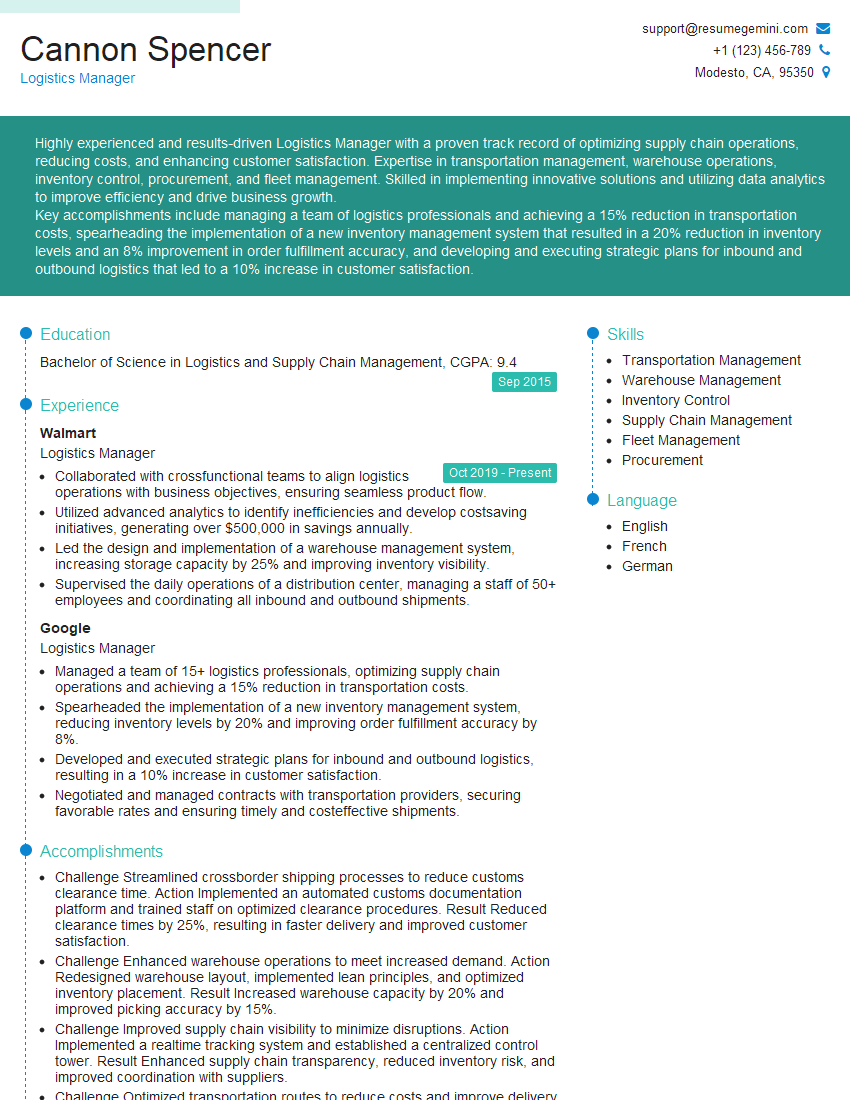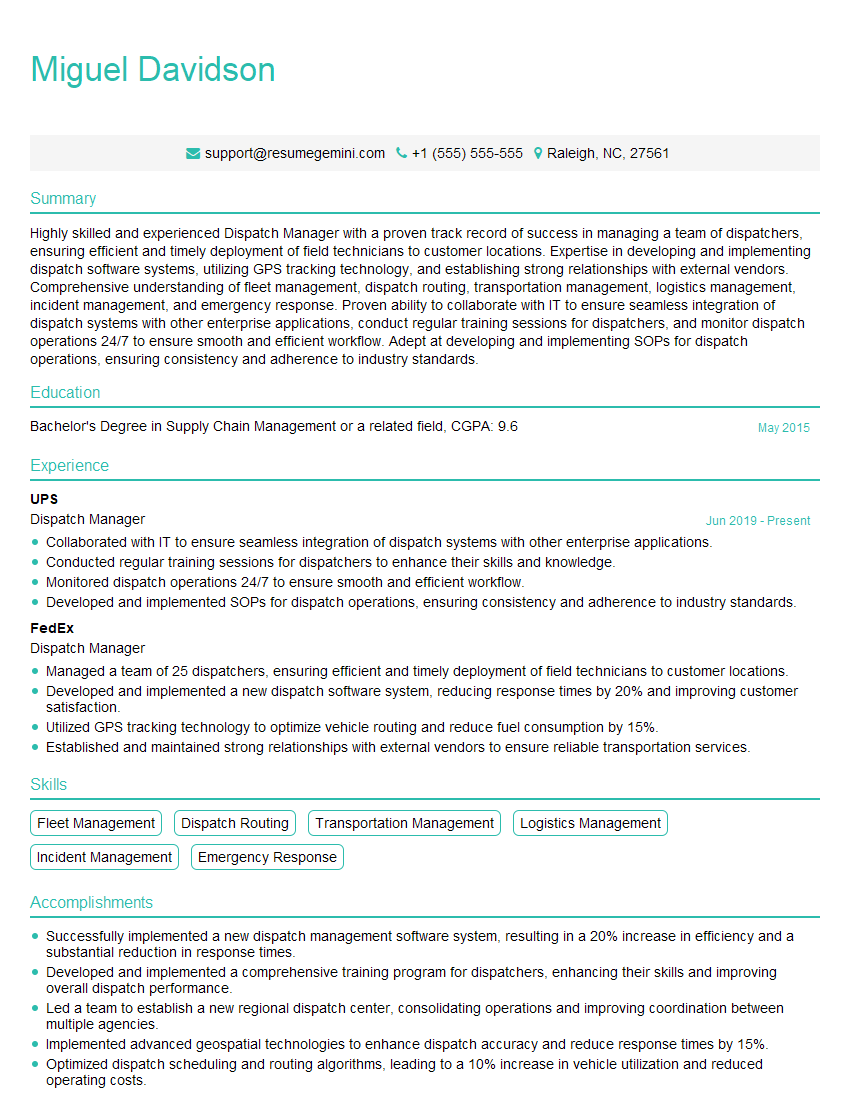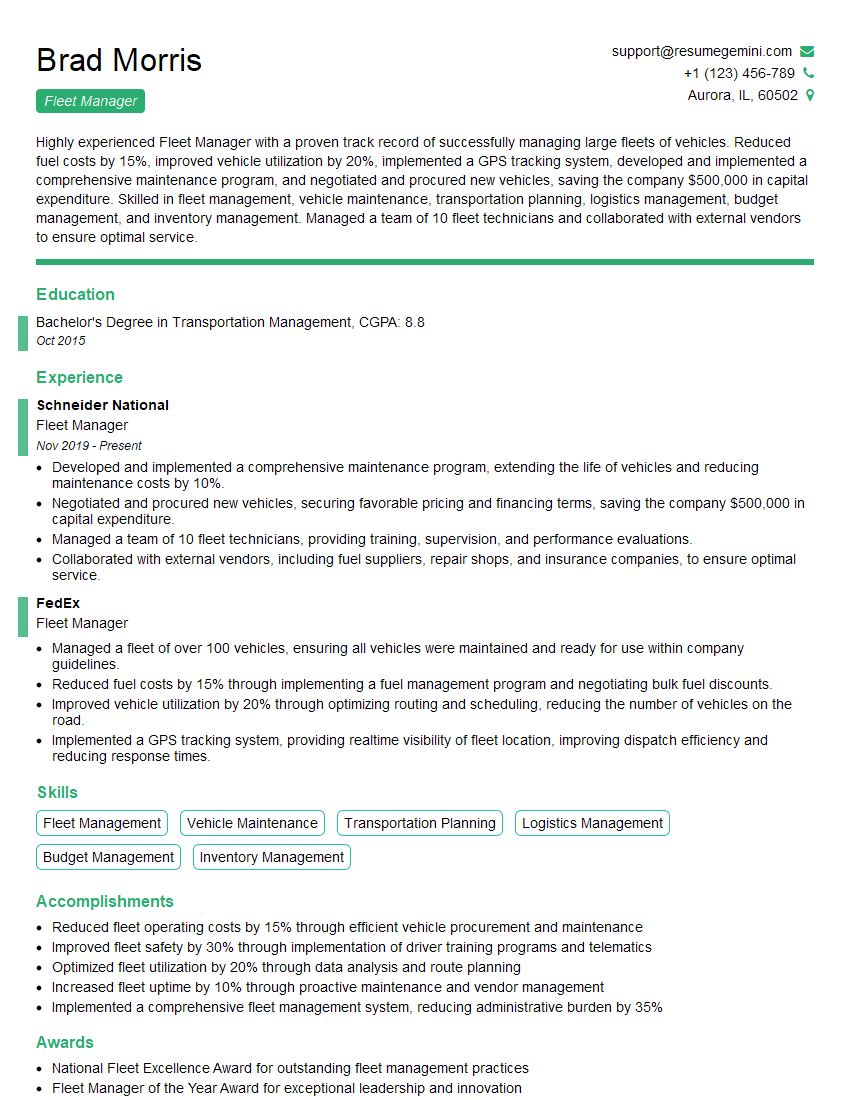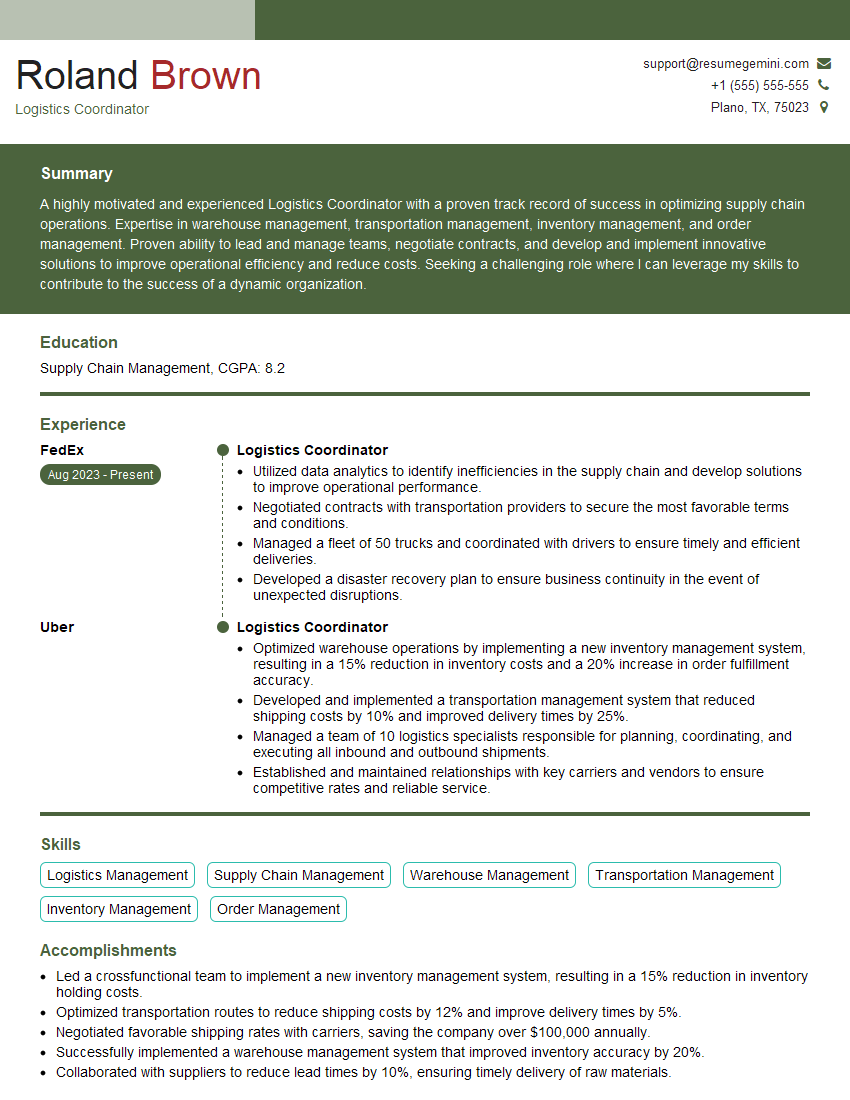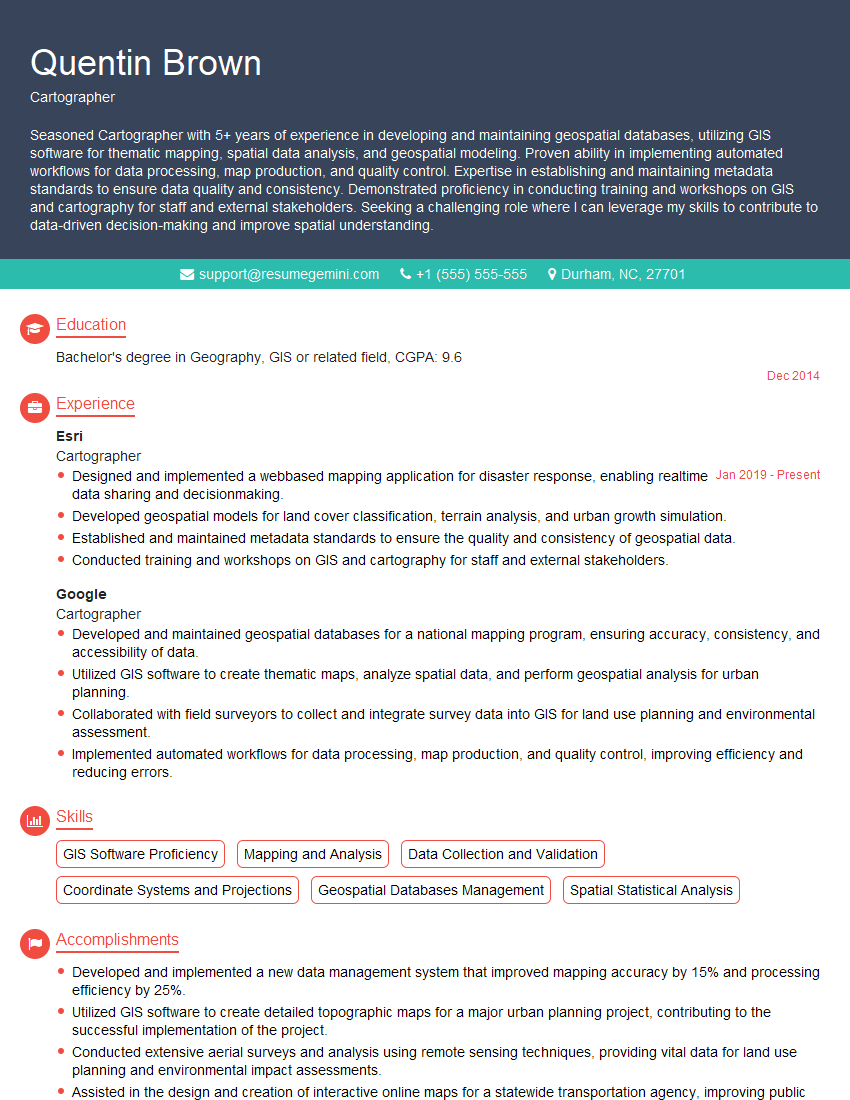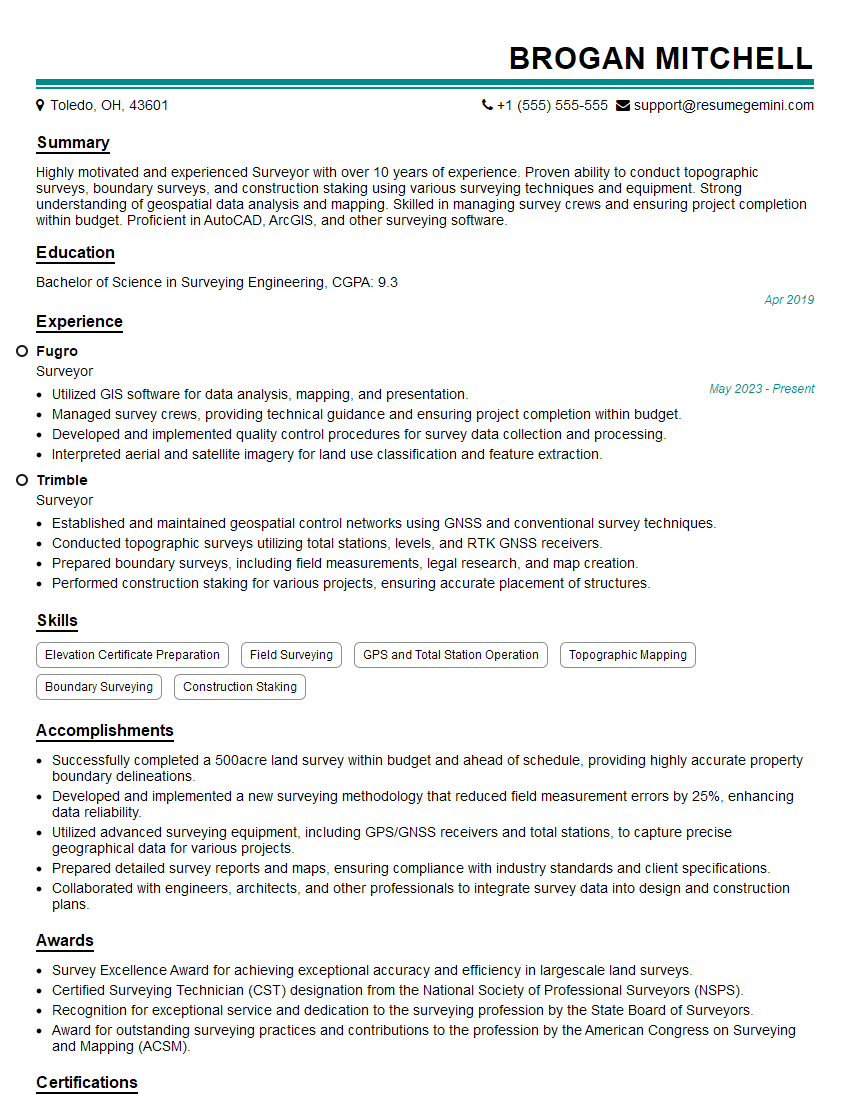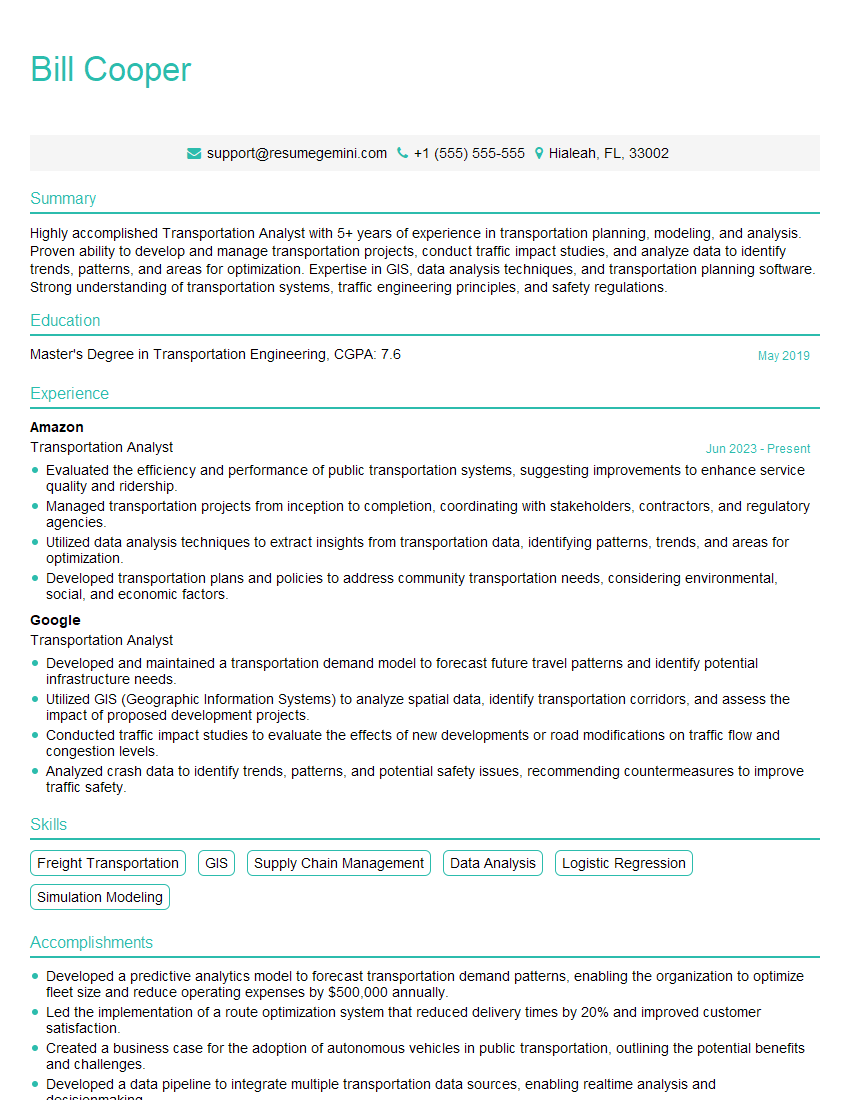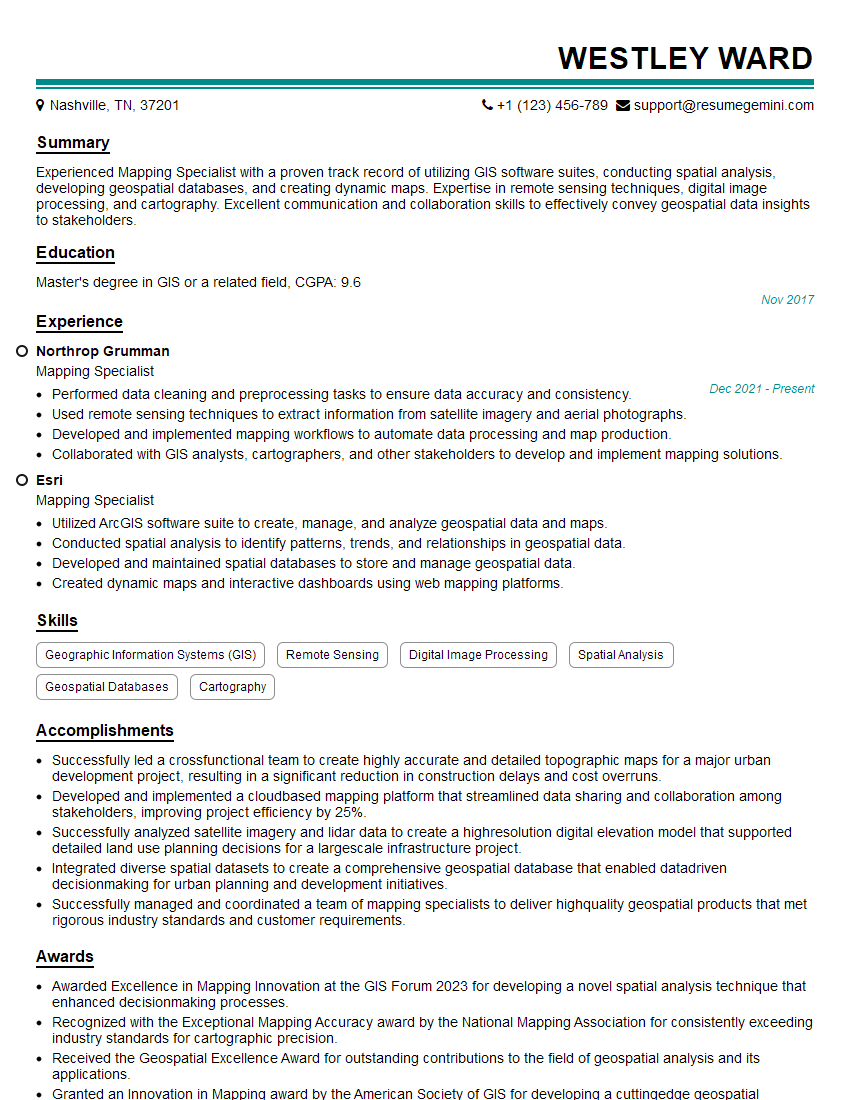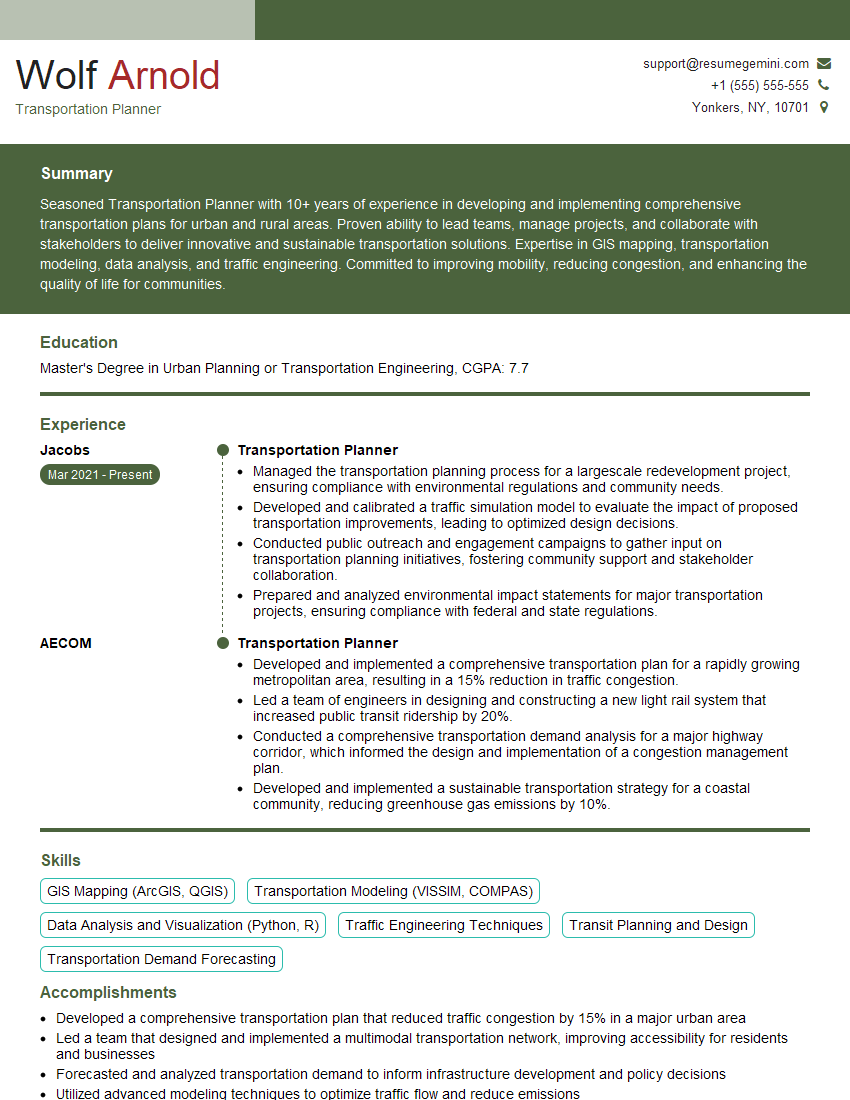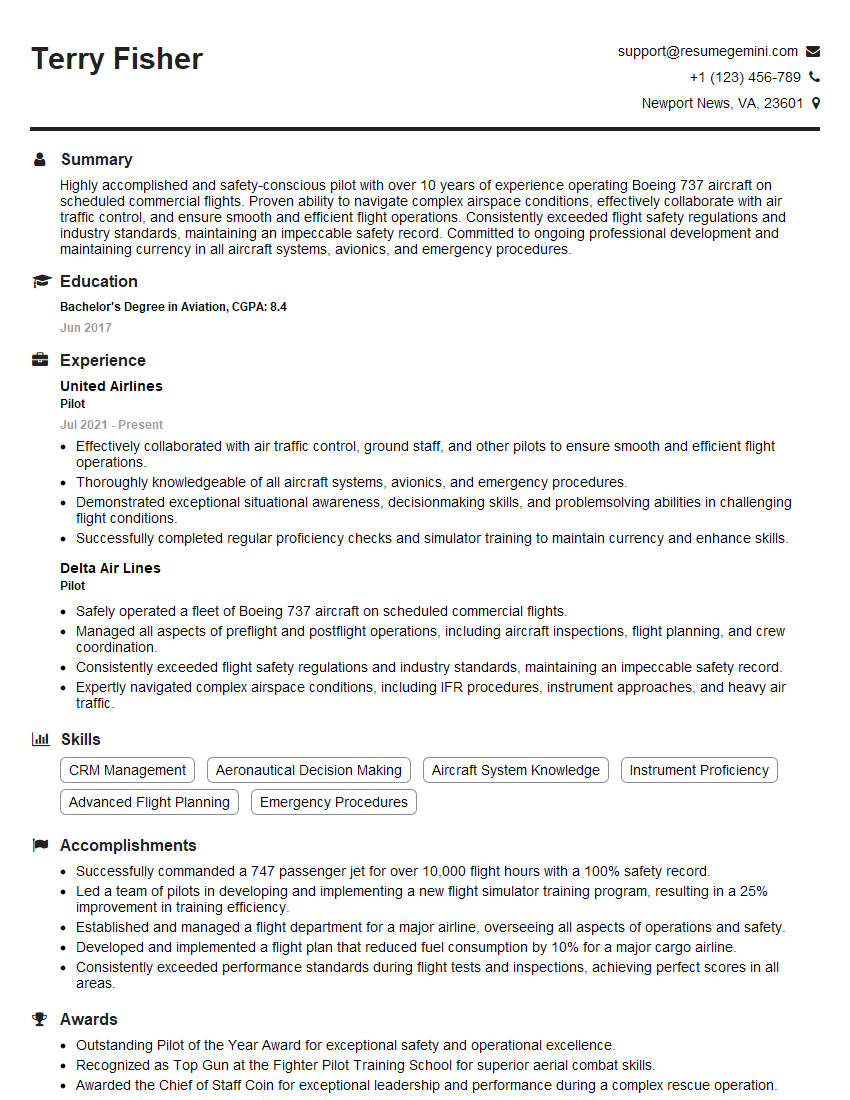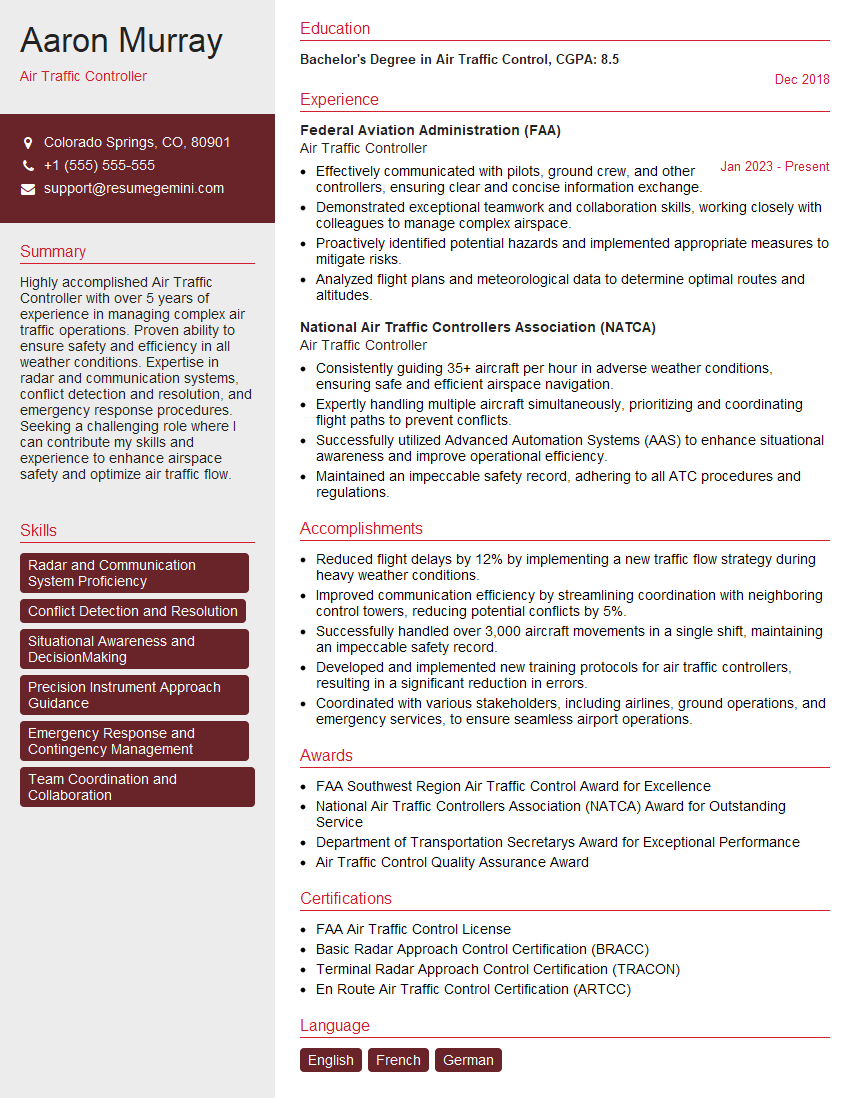Are you ready to stand out in your next interview? Understanding and preparing for Navigation and Route Finding interview questions is a game-changer. In this blog, we’ve compiled key questions and expert advice to help you showcase your skills with confidence and precision. Let’s get started on your journey to acing the interview.
Questions Asked in Navigation and Route Finding Interview
Q 1. Explain the difference between latitude and longitude.
Latitude and longitude are coordinates that specify a location on the Earth’s surface. Think of it like a grid system covering the globe. Latitude measures the distance north or south of the Equator, ranging from 0° (Equator) to 90° (North and South Poles). Lines of latitude are parallel to each other and are called parallels. Longitude measures the distance east or west of the Prime Meridian (which passes through Greenwich, England), ranging from 0° to 180° (East and West). Lines of longitude converge at the poles and are called meridians. Together, a latitude and longitude pair uniquely pinpoint a location.
For example, the coordinates 40.7128° N, 74.0060° W represent a location in New York City. The 40.7128° N indicates its latitude north of the equator, and 74.0060° W indicates its longitude west of the Prime Meridian.
Q 2. Describe different types of map projections and their applications.
Map projections are methods used to represent the three-dimensional Earth’s surface on a two-dimensional map. Because the Earth is a sphere and a map is flat, some distortion is unavoidable. Different projections minimize different types of distortion. Here are a few common types:
- Mercator Projection: Preserves direction and shape locally, but significantly distorts area, especially near the poles. It’s commonly used for navigation because straight lines represent constant compass bearings (rhumb lines).
- Lambert Conformal Conic Projection: Minimizes distortion in areas of relatively small latitudinal extent, making it suitable for mapping regions stretching along lines of latitude. Useful for aviation and mid-latitude regions.
- Albers Equal-Area Conic Projection: Preserves area accurately, but distorts shapes. Ideal for displaying spatial data where the area is critical, such as landmass representation or population density mapping.
- Gnomonic Projection: Great for long-distance navigation. All great circles (shortest routes between two points on a sphere) appear as straight lines, but severely distorts shape and area, especially away from the central point.
The choice of projection depends heavily on the application. For navigation, where accurate direction is paramount, a Mercator projection is often preferred. For thematic mapping focused on accurate area representation, an equal-area projection is better suited.
Q 3. What are the common sources of error in GPS navigation?
GPS navigation relies on signals from satellites, and several factors can introduce errors:
- Atmospheric Effects: The ionosphere and troposphere can delay or refract GPS signals, leading to positional errors. This is particularly true during periods of high solar activity or atmospheric instability.
- Multipath Errors: Signals can bounce off buildings or other surfaces before reaching the receiver, causing inaccurate measurements. This is a common problem in urban canyons.
- Satellite Geometry: The geometry of the satellites visible to the receiver affects the accuracy of the position fix. Poor geometry, such as when satellites are clustered together in the sky, can lead to greater uncertainty.
- Signal Obstruction: Buildings, trees, or other obstacles can block the GPS signal, resulting in loss of signal or inaccurate readings.
- Receiver Noise and Errors: The GPS receiver itself can introduce errors due to internal noise or faulty components.
- Selective Availability (SA): Although no longer active, it is historically relevant, as it was a deliberate degradation of the GPS signal introduced by the US government.
Sophisticated GPS receivers utilize techniques such as differential GPS (DGPS) and Real-Time Kinematic (RTK) GPS to mitigate these errors, achieving centimeter-level accuracy in some cases.
Q 4. How do you interpret topographic maps?
Topographic maps depict the Earth’s surface, including elevation, terrain features, and man-made structures. Interpreting them involves understanding their symbology:
- Contour Lines: These lines connect points of equal elevation. Closer contour lines indicate steeper slopes, while widely spaced lines indicate gentler slopes. The contour interval (difference in elevation between consecutive lines) is usually indicated on the map.
- Elevation Points: These points provide exact elevation values, often helpful for verifying the elevation represented by contour lines.
- Relief Shading: Creates a three-dimensional effect by shading areas based on slope and aspect. Darker shading usually indicates a steeper slope.
- Symbols: Represent various features like buildings, roads, rivers, vegetation, and land use.
To interpret a topographic map effectively, always start by examining the map’s legend and scale. Identify key features and relate them to the contour lines to visualize the terrain. Practicing reading topographic maps is crucial for activities like hiking, land surveying, and urban planning.
Q 5. Explain the concept of dead reckoning.
Dead reckoning is a navigation technique that estimates a vehicle’s current position based on its previously known position, speed, heading, and the elapsed time. It’s essentially calculating where you should be based on your movements, without any external references like GPS. Imagine sailing a ship – you know your starting point, speed, and direction. Using this information, you can estimate your position after a few hours. However, it relies on accurate inputs and accumulates errors over time.
The formula is relatively straightforward: New Position = Old Position + (Speed × Time × Direction).
Dead reckoning is a vital backup navigation method, particularly when other navigation systems fail. It was historically critical in sea and air navigation before the advent of modern technologies. Although less precise than modern techniques, it’s still valuable in situations where other methods are unavailable.
Q 6. What are some common navigation tools and technologies?
Modern navigation relies on a variety of tools and technologies:
- GPS Receivers: Provide accurate positioning data using signals from orbiting satellites.
- Electronic Charts (ECDIS): Digital versions of nautical charts, providing a wealth of navigational information.
- Inertial Navigation Systems (INS): Use accelerometers and gyroscopes to track movement and calculate position, independent of external signals.
- Gyrocompass: A type of compass that uses a spinning gyroscope to determine true north, independent of magnetic fields.
- Magnetic Compass: A traditional compass that uses the Earth’s magnetic field to indicate magnetic north.
- Celestial Navigation: A historical technique that utilizes the positions of celestial bodies to determine latitude and longitude.
- Navigation Apps (Smartphone Apps): User-friendly apps using GPS and map data for route planning and navigation.
- GIS Software (Geographic Information Systems): Powerful software for managing, analyzing, and visualizing geospatial data.
The choice of navigation tools depends on the context. For example, a ship might rely on a combination of GPS, ECDIS, and gyrocompass, while a hiker might use a handheld GPS and a topographic map.
Q 7. Describe different route planning algorithms.
Route planning algorithms determine the optimal path between two points based on various criteria. Some common algorithms include:
- Dijkstra’s Algorithm: Finds the shortest path between nodes in a graph with non-negative edge weights. It’s widely used for road networks where the edge weight represents distance or travel time.
- A* Search Algorithm: A heuristic search algorithm that efficiently finds the shortest path by using a heuristic function to estimate the distance to the goal. It’s widely used in games and robotics due to its efficiency.
- Floyd-Warshall Algorithm: Finds the shortest paths between all pairs of nodes in a graph. Useful for pre-computing shortest paths for a whole network, improving query time later.
- Ant Colony Optimization (ACO): A metaheuristic algorithm inspired by the foraging behavior of ants. It’s particularly useful for dynamic routing problems where road conditions might change.
The choice of algorithm often depends on factors like the size of the graph, the nature of the cost function, and whether the graph is static or dynamic. For example, Dijkstra’s algorithm is a good choice for static road networks, whereas ACO is more suited to dynamic routing problems with traffic congestion.
Q 8. How do you handle unexpected obstacles or road closures during route planning?
Handling unexpected obstacles during route planning requires a robust system capable of real-time adjustments. My approach involves several key strategies. First, I utilize real-time data feeds from sources like traffic monitoring systems and incident reports to identify road closures or significant delays. Second, the routing algorithm should not only find the shortest path but also incorporate a ‘cost’ function that accounts for factors like traffic, road type, and distance. Third, the system needs a fallback mechanism. If a planned route is blocked, the algorithm should recalculate an alternate route using the updated data. This might involve exploring multiple alternatives, prioritizing speed or distance depending on the context. For instance, if a highway is closed, a detour through residential streets might be chosen, even if it adds to the travel time. The system should also provide the user with clear notifications regarding the changes in the route and the expected impact on travel time.
Imagine planning a delivery route for a courier company. A sudden accident closes a major highway. A system without real-time updates would likely fail to reroute, causing delays and potentially missed deliveries. However, a sophisticated system would instantly detect the closure, use alternative roads, update the driver’s navigation app, and perhaps even send alerts to the customer.
Q 9. Explain the concept of Dijkstra’s algorithm in route finding.
Dijkstra’s algorithm is a classic graph search algorithm used to find the shortest path between nodes in a graph. Think of a road network as a graph, where intersections are nodes and roads are edges. Each edge has a weight representing the distance or travel time. Dijkstra’s algorithm works by iteratively exploring nodes, starting from a source node. It maintains a set of visited nodes and a set of unvisited nodes. At each step, it selects the unvisited node with the smallest distance from the source, marks it as visited, and updates the distances to its neighbors. This process continues until the destination node is visited.
The beauty of Dijkstra’s algorithm lies in its efficiency and simplicity. It guarantees finding the shortest path if all edge weights are non-negative. While efficient for smaller networks, its time complexity can increase significantly for large graphs. However, its foundational principles are still used in many modern navigation systems, often optimized or combined with other algorithms for better performance in real-world scenarios.
//Illustrative pseudocode snippet: function dijkstra(graph, source): distances = array filled with infinity for each node distances[source] = 0 unvisited = set of all nodes while unvisited is not empty: current = node in unvisited with smallest distance remove current from unvisited for each neighbor of current: newDistance = distances[current] + distance(current, neighbor) if newDistance < distances[neighbor]: distances[neighbor] = newDistance return distances Q 10. What are the key factors to consider when optimizing delivery routes?
Optimizing delivery routes involves a multi-faceted approach. The core aim is to minimize total travel time, distance, or cost while satisfying constraints like time windows for deliveries and vehicle capacity. Key factors include:
- Time windows: Deliveries often have specified time ranges. The algorithm must consider these constraints to ensure timely delivery.
- Vehicle capacity: The route must be planned such that the vehicle doesn't exceed its load capacity. This might require splitting deliveries among multiple vehicles.
- Traffic conditions: Real-time traffic data is crucial for accurate time estimations and route selection.
- Distance and travel time: These are fundamental factors. Algorithms like Dijkstra's or more sophisticated methods like the Vehicle Routing Problem (VRP) solvers are employed.
- Number of stops: Minimizing the number of stops, while satisfying other constraints, can significantly improve efficiency.
- Fuel costs: Route optimization might consider fuel efficiency and minimize overall fuel consumption.
In practice, this might involve using specialized software that takes all these factors into account and provides the most efficient route. For example, a logistics company might use a VRP solver to plan daily routes for its fleet of delivery trucks, taking into account delivery deadlines, package weights, and real-time traffic updates.
Q 11. How do you calculate travel time considering traffic conditions?
Calculating travel time considering traffic conditions requires integrating real-time traffic data with traditional route planning algorithms. This involves accessing data from various sources, such as GPS devices, traffic cameras, and smartphone apps. This data provides information on speed, congestion levels, incidents, and road closures. The algorithm then incorporates this dynamic information to adjust the estimated travel time for each road segment. Instead of using a static travel speed, the algorithm will use a variable speed based on the current traffic conditions. Advanced techniques involve using machine learning to predict future traffic patterns and incorporate these predictions into the travel time calculations.
For instance, a navigation app might predict a significant delay on a highway due to an accident reported on a traffic service. It would then recalculate the route, potentially suggesting an alternative with less traffic, adjusting the estimated time of arrival accordingly. The accuracy of this prediction depends on the reliability of the traffic data and the sophistication of the prediction model.
Q 12. Describe your experience with GIS software (e.g., ArcGIS, QGIS).
I have extensive experience using GIS software, primarily ArcGIS and QGIS. In my previous role, I utilized ArcGIS for creating and managing spatial data related to transportation networks. I built and maintained road network datasets, incorporating data from various sources like OpenStreetMap, government agencies, and proprietary mapping services. This involved data cleaning, validation, and ensuring data consistency and accuracy. I also used ArcGIS for spatial analysis tasks such as network analysis for route planning and optimization. QGIS offered flexibility and an open-source alternative for specific tasks involving custom scripting and specialized plugins.
For example, I used ArcGIS to analyze the impact of a proposed highway expansion on traffic flow in a given area. This involved modeling the new road network in ArcGIS and running network analysis to compare travel times before and after the expansion. This analysis aided in decision-making regarding the project.
Q 13. How do you ensure the accuracy of navigation data?
Ensuring the accuracy of navigation data is paramount. My approach focuses on multiple layers of validation and verification. First, data from multiple sources are integrated. This helps cross-reference information and identify discrepancies. For example, comparing data from OpenStreetMap with official road network data can identify inconsistencies. Second, data quality checks and cleaning procedures are employed. This involves identifying and correcting errors, such as duplicate road segments, missing data, or incorrect road attributes. Third, regular updates are essential, especially for dynamic data such as traffic information and speed limits. Finally, field validation might be necessary in some cases to verify the accuracy of data through on-site observation or ground truthing. Regular audits and quality control measures help maintain data integrity over time.
Imagine a navigation system relying on outdated road data. The system could direct users down a road that no longer exists, causing confusion and potentially dangerous situations. This underscores the importance of diligent data management and validation processes to ensure accuracy.
Q 14. What is the importance of spatial data in navigation?
Spatial data is the foundation of navigation. It provides the 'map' that enables route finding and location-based services. Without spatial data representing roads, landmarks, buildings, and other geographical features, navigation would be impossible. Spatial data encompasses not only the geometric location of features (coordinates) but also their attributes, such as road type, speed limits, one-way restrictions, and elevation. This rich information is crucial for algorithms to generate accurate and efficient routes. The ability to analyze spatial relationships between different features (proximity, connectivity) is also critical for tasks such as identifying points of interest near a route, analyzing traffic patterns, or optimizing delivery routes.
In essence, spatial data forms the bedrock upon which all navigation systems are built. Without it, there would be no way to understand the layout of the world and plan a path from one point to another.
Q 15. Explain the concept of geofencing.
Geofencing is a location-based service that uses GPS or RFID technology to define a virtual geographic boundary around a real-world geographic area. When a mobile device or other tracked object enters, exits, or dwells within that boundary, it triggers a pre-programmed action or alert.
Think of it like setting an invisible fence for your dog. Instead of a physical fence, you define a digital boundary on a map. When your dog (or in this case, your device) crosses that boundary, you get a notification.
Real-world applications include:
- Fleet Management: Monitoring vehicles to ensure they stay within designated areas (e.g., delivery zones).
- Asset Tracking: Locating valuable equipment or inventory to prevent theft or loss.
- Security: Triggering alarms when unauthorized personnel enter restricted zones.
- Marketing: Sending targeted advertisements or promotions to customers within a specific geographic region (e.g., a radius around a store).
Geofencing relies on accurate location data and requires defining the boundaries precisely. The complexity increases with the size and shape of the area and the required accuracy of triggering events.
Career Expert Tips:
- Ace those interviews! Prepare effectively by reviewing the Top 50 Most Common Interview Questions on ResumeGemini.
- Navigate your job search with confidence! Explore a wide range of Career Tips on ResumeGemini. Learn about common challenges and recommendations to overcome them.
- Craft the perfect resume! Master the Art of Resume Writing with ResumeGemini's guide. Showcase your unique qualifications and achievements effectively.
- Don't miss out on holiday savings! Build your dream resume with ResumeGemini's ATS optimized templates.
Q 16. How do you handle multiple conflicting route optimization objectives?
Route optimization often involves multiple, sometimes conflicting, objectives. For example, we might want the fastest route, the shortest route, or the most fuel-efficient route. These objectives rarely align perfectly.
Handling conflicting objectives requires a multi-criteria decision-making approach. Here's a common strategy:
- Identify Objectives and Weights: Explicitly list all optimization objectives (e.g., minimizing travel time, minimizing distance, minimizing fuel consumption). Assign weights to each objective reflecting its relative importance. For instance, minimizing travel time might have a weight of 0.6, minimizing distance 0.3, and minimizing fuel consumption 0.1.
- Scoring System: Develop a scoring system for each objective. For each potential route, calculate a score for each objective (e.g., travel time in minutes, distance in kilometers, fuel consumption in liters). Normalize these scores (e.g., scale them to a range of 0-1) to allow for comparison across different objectives.
- Weighted Sum: Combine the normalized scores using the assigned weights. The route with the highest weighted sum is considered the optimal route, representing the best compromise between the conflicting objectives. For instance:
Weighted Score = (0.6 * Normalized Travel Time Score) + (0.3 * Normalized Distance Score) + (0.1 * Normalized Fuel Consumption Score) - Pareto Optimality: For more complex scenarios, explore the concept of Pareto optimality, where no objective can be improved without worsening another. This often leads to a set of 'efficient' routes instead of a single optimal route, allowing the user to choose based on their preferences.
The specific techniques used will depend on the context (e.g., type of vehicle, road network characteristics, and available data).
Q 17. Describe your experience with different map data formats.
I have extensive experience with various map data formats, including:
- Shapefiles (.shp): A widely used geospatial vector format for storing geographic data as points, lines, and polygons. I've used them for representing road networks, building footprints, and administrative boundaries.
- GeoJSON: A lightweight, text-based format that's increasingly popular due to its ease of use and compatibility with web mapping technologies. I've used it for data exchange between different mapping systems and web applications.
- GeoPackage (.gpkg): A versatile format supporting both vector and raster data, offering better performance and scalability compared to Shapefiles. I've found it particularly useful for large datasets and mobile applications.
- Mapbox Vector Tiles (MVT): Optimized for web map rendering, they allow for efficient handling of large datasets by serving only the tiles visible on the screen. My experience includes integrating this format into web applications for interactive mapping.
- Raster formats (e.g., GeoTIFF, IMG): Used extensively for satellite imagery and elevation data; I've used these to incorporate terrain data into route planning algorithms, particularly for off-road navigation.
My experience involves not only reading and interpreting these formats but also converting between them as needed, depending on the specific requirements of a project or application.
Q 18. What are the limitations of GPS in certain environments?
GPS relies on signals from satellites, and its accuracy and reliability can be compromised in several environments:
- Urban Canyons: Tall buildings can block satellite signals, leading to poor accuracy or signal loss. Multipath effects (signals bouncing off buildings) can also introduce errors.
- Dense Foliage: Trees and other vegetation can significantly attenuate GPS signals, making it difficult to obtain accurate location information.
- Tunnels and Underground Spaces: GPS signals cannot penetrate solid structures, rendering the system useless in these environments.
- Adverse Weather Conditions: Heavy rain, snow, or fog can interfere with GPS signals, reducing accuracy and availability.
- Atmospheric Interference: Ionospheric and tropospheric disturbances can affect signal propagation and introduce errors.
- Signal Jamming and Spoofing: Intentional interference with GPS signals can lead to inaccuracies or complete signal loss. Spoofing involves transmitting false GPS signals, potentially leading to incorrect navigation information.
Mitigation strategies often involve integrating GPS with other technologies like inertial navigation systems (INS) or sensor fusion techniques.
Q 19. How would you assess the reliability of a navigation system?
Assessing the reliability of a navigation system requires a multi-faceted approach.
- Accuracy Testing: Conduct rigorous tests in various environments (urban, rural, different weather conditions) to determine the system's positional accuracy and compare it to reference data (e.g., high-precision surveying data).
- Availability Assessment: Measure the percentage of time the system provides a valid location fix and identify potential areas of poor signal availability.
- Route Planning Evaluation: Compare the routes generated by the system to real-world routes in terms of distance, travel time, and safety. Evaluate the system's ability to handle unexpected events (e.g., road closures).
- Data Integrity Check: Examine the quality and currency of map data used by the system, ensuring it accurately reflects the real-world road network and includes relevant points of interest.
- Error Handling and Recovery: Assess how the system handles signal loss or other errors, including the mechanisms for error detection and recovery. For example, does the system gracefully degrade its performance in a challenging environment or does it simply stop functioning?
- User Feedback: Collect user feedback on the system's usability and reliability to identify any recurring issues or areas for improvement.
The overall reliability is determined by a combination of these factors, and often quantified using metrics like mean error, standard deviation of error, availability rate, and user satisfaction ratings.
Q 20. Explain your experience with route planning software.
My experience with route planning software spans a wide range of tools and technologies, from commercial packages like ArcGIS Network Analyst and Google Maps Platform to open-source libraries such as OpenTripPlanner and GraphHopper.
I'm proficient in using these tools to:
- Develop and optimize routes: Considering factors like distance, time, cost, and road restrictions.
- Analyze network connectivity: Identifying shortest paths, optimal routes for different vehicle types, and potential bottlenecks.
- Integrate various data sources: Combining map data, traffic information, and other relevant datasets to improve route planning accuracy.
- Develop custom algorithms: Implementing specialized route-finding algorithms to address specific requirements or constraints.
- Generate route visualizations: Creating maps and other visual representations of planned routes for easy understanding and communication.
My work has involved using these tools for projects ranging from urban transportation planning to logistics optimization and disaster response planning.
Q 21. What is your understanding of A* search algorithm?
The A* search algorithm is a graph traversal and path search algorithm, which is often used in many fields of computer science due to its completeness, optimality, and efficiency. It's particularly well-suited for finding the shortest path between two nodes in a graph, especially when a heuristic function is available to estimate the distance to the goal.
Key components:
- Open Set: A list of nodes to be evaluated.
- Closed Set: A list of nodes already evaluated.
- f(n): The total estimated cost of the path through node n to the goal. f(n) = g(n) + h(n)
- g(n): The cost of the path from the start node to node n.
- h(n): A heuristic function that estimates the cost of the cheapest path from node n to the goal. A good heuristic is crucial for A*'s efficiency. It must be admissible (never overestimates the actual cost) and consistent (the estimated cost from n to the goal plus the cost to reach n from the start is always less than or equal to the cost from the start to the goal through some neighbor of n).
How it works:
- Start with the initial node in the open set.
- Iteratively select the node with the lowest f(n) from the open set.
- Add the selected node to the closed set.
- For each neighbor of the selected node, calculate g(n), h(n), and f(n).
- If a neighbor is already in the closed set, ignore it. Otherwise, add it to the open set (or update its f(n) if it's already in the open set).
- Repeat steps 2-5 until the goal node is selected.
- Reconstruct the path by backtracking from the goal node to the start node.
A* is widely used in navigation systems, game AI, robotics, and other applications where finding optimal paths is crucial. The choice of heuristic significantly impacts its performance. Different heuristics can be tailored for different scenarios, and improperly chosen heuristics may lead to very slow or inefficient pathfinding.
Q 22. How do you deal with incomplete or inaccurate map data?
Dealing with incomplete or inaccurate map data is a critical aspect of navigation system development. It's rarely the case that we have perfect data. Our approach involves a multi-pronged strategy focusing on data validation, error detection, and robust algorithms.
Data Validation: We employ techniques to identify inconsistencies and potential errors within the map data itself. This includes checking for topological errors (e.g., roads that abruptly end), inconsistencies in speed limits, and missing or conflicting attributes.
Sensor Fusion: We integrate data from multiple sources, such as GPS, IMU (Inertial Measurement Unit), and odometry, to cross-reference and compensate for inaccuracies in the map. For example, if the map shows a road closed, but our GPS and IMU data indicate the vehicle is traversing it, we trigger a recalculation or alert the user.
Probabilistic Approaches: Rather than relying on a single, potentially flawed data point, we use probabilistic methods like Kalman filtering. These methods weigh various data sources based on their reliability and continuously update the vehicle's estimated position, even with noisy or incomplete input. This approach helps to smoothly navigate areas with less precise map details.
Crowdsourcing: Leveraging user-generated data, such as speed information, road closures, and construction zones, provides real-time updates that fill in gaps in the static map data. This is particularly useful in addressing dynamic road conditions that traditional mapping data may not capture.
Imagine a scenario where a new road is opened, but the map hasn't yet been updated. By fusing sensor data with crowdsourced information, the navigation system can adapt to this change and provide accurate guidance.
Q 23. Explain the principles of inertial navigation systems.
Inertial Navigation Systems (INS) are self-contained navigation systems that determine position, velocity, and orientation using measurements from accelerometers and gyroscopes. The core principle relies on integrating acceleration and angular rate to calculate position and orientation. This is done in a three-dimensional coordinate system.
Here's a simplified breakdown:
Accelerometers measure linear acceleration. By integrating the acceleration over time, we can obtain velocity.
Gyroscopes measure angular rate (how fast the system is rotating). Integrating this gives us orientation.
Integration Process: The raw sensor data are noisy. To improve accuracy, sophisticated algorithms, often involving Kalman filters, are used. This process refines estimates, reducing the impact of sensor noise and drift.
Drift: However, a significant challenge with INS is sensor drift. Errors accumulate over time in the integration process, causing the estimated position to drift from the true position. Therefore, INS is often used in conjunction with other navigation systems, such as GPS, to mitigate this drift.
Example: In aircraft navigation, INS is commonly used for short periods. It might guide the plane between GPS updates or in GPS-denied environments. The system will constantly be updated and corrected by other means to minimize the error caused by drift.
Q 24. Describe different types of sensors used in navigation.
Navigation systems rely on a variety of sensors to gather information about the environment and the vehicle's position and movement. The choice of sensors depends on the application and its specific needs.
GPS (Global Positioning System): Provides latitude, longitude, and altitude information. Relies on signals from satellites.
IMU (Inertial Measurement Unit): Consists of accelerometers and gyroscopes, measuring acceleration and rotation rates. Used for short-term position and orientation estimation and for filling in gaps in GPS data.
Odometry: Measures wheel rotation to estimate distance traveled. Used in conjunction with other sensors to improve accuracy and consistency.
Magnetometer: Measures the Earth's magnetic field to determine heading. Can be affected by metallic objects.
Barometer: Measures atmospheric pressure to estimate altitude. Particularly useful in GPS-challenged areas.
LiDAR (Light Detection and Ranging): Creates a 3D map of the surroundings by emitting laser pulses and measuring the time of return. Excellent for autonomous vehicle navigation and obstacle detection.
Camera: Provides visual information for object recognition, lane detection, and map matching. Commonly used in advanced driver-assistance systems (ADAS) and autonomous vehicles.
For instance, a drone might use GPS, IMU, and a barometer for navigation, whereas an autonomous car would incorporate GPS, IMU, LiDAR, cameras, and odometry for a more robust and comprehensive understanding of its surroundings.
Q 25. What are the ethical considerations related to navigation technology?
Ethical considerations in navigation technology are significant and multifaceted. They encompass issues of privacy, security, and fairness.
Data Privacy: Navigation systems collect vast amounts of location data. Protecting this data from unauthorized access and misuse is paramount. Transparency about data collection practices and user consent are essential.
Security Vulnerabilities: Navigation systems can be vulnerable to cyberattacks, potentially leading to malfunctions or the manipulation of location information. Robust security measures, including encryption and authentication protocols, are crucial to preventing such incidents.
Algorithmic Bias: Navigation algorithms can reflect existing societal biases, leading to unequal access to services or discriminatory outcomes. Ensuring fairness and mitigating bias in algorithm design and implementation is a key challenge.
Surveillance Concerns: The widespread use of navigation technology raises concerns about mass surveillance. The potential for tracking individuals without their knowledge or consent needs careful consideration and appropriate regulation.
Autonomous Vehicles and Responsibility: Ethical dilemmas arise in the context of autonomous vehicles. Determining liability in cases of accidents, defining acceptable levels of risk, and ensuring ethical decision-making in critical situations are complex challenges that require careful consideration.
For example, an autonomous vehicle's navigation system must be programmed to handle ethical dilemmas such as choosing between hitting a pedestrian or swerving into oncoming traffic. These scenarios highlight the need for careful ethical considerations in the design and deployment of navigation systems.
Q 26. How do you ensure the security of navigation data?
Ensuring the security of navigation data requires a layered approach combining various techniques.
Data Encryption: Protecting data at rest and in transit using strong encryption algorithms (e.g., AES) prevents unauthorized access.
Authentication and Authorization: Implementing robust authentication protocols verifies the identity of users and devices accessing the navigation system. Authorization mechanisms control what actions users are permitted to perform.
Secure Communication Channels: Using secure protocols like HTTPS ensures the confidentiality and integrity of communication between devices and servers.
Regular Security Audits: Conducting regular security assessments identifies vulnerabilities and ensures that the system remains resilient against attacks.
Intrusion Detection and Prevention Systems: Deploying systems that detect and prevent malicious activities, such as attempts to compromise the navigation system or steal data.
Secure Software Development Practices: Following secure coding guidelines throughout the development process minimizes the risk of vulnerabilities being introduced into the system.
For example, the encryption of map data prevents unauthorized access to sensitive information, while authentication ensures only legitimate users can access the system and make updates to the navigation data.
Q 27. Explain your experience working with real-time traffic data.
My experience with real-time traffic data involves integrating it into navigation systems to provide users with optimal routes and accurate estimated times of arrival (ETAs). This typically involves:
Data Acquisition: Accessing traffic data feeds from various sources, including government agencies, commercial providers (e.g., TomTom, Inrix), and crowdsourced data platforms.
Data Processing: Cleaning and validating the traffic data to ensure accuracy and reliability. This often involves handling inconsistencies, missing data points, and outliers.
Route Optimization: Developing algorithms that dynamically adjust route suggestions based on real-time traffic conditions, prioritizing routes with minimal congestion.
ETA Calculation: Accurately predicting arrival times based on current traffic flow and speed. This requires sophisticated algorithms that consider various factors like traffic density, incident reports, and road construction.
Visualization: Presenting traffic information visually on the navigation interface, using color-coded maps and other visual cues to clearly show congestion levels.
In one project, I worked on integrating real-time traffic data into a navigation app for a major city. By incorporating data from various sources and using advanced route-optimization algorithms, we were able to reduce average travel times by approximately 15%, improving user satisfaction significantly.
Q 28. How would you design a navigation system for a specific application (e.g., autonomous vehicles, drones)?
Designing a navigation system for a specific application, such as autonomous vehicles or drones, requires a tailored approach.
Autonomous Vehicles:
Sensor Fusion: A comprehensive sensor suite, including LiDAR, cameras, radar, and IMU, is essential for precise perception of the surroundings.
High-Definition Mapping: Accurate and detailed maps are crucial, including lane markings, road curvature, and obstacle information.
Path Planning and Control: Sophisticated algorithms are necessary to plan safe and efficient paths, considering obstacles, traffic conditions, and regulations.
Localization: Robust techniques are required to accurately determine the vehicle's position and orientation in the environment.
Drones:
GPS and IMU Integration: Accurate positioning and orientation are vital. GPS may be supplemented by other sensors depending on the environment.
Obstacle Avoidance: Algorithms that detect and avoid obstacles, including trees, buildings, and other drones, are essential.
Flight Planning: Tools that enable the creation and execution of flight paths, including waypoint navigation and autonomous return-to-home functionality.
Communication Systems: Reliable communication links are necessary for remote control and data transmission.
For both applications, rigorous testing and validation are crucial to ensure safety and reliability. The design must account for potential failures and incorporate appropriate safety mechanisms.
Key Topics to Learn for Navigation and Route Finding Interview
- Map Reading and Interpretation: Understanding various map types (topographic, nautical, aeronautical), symbols, scales, and projections. Practical application: Analyzing a map to plan a route, identify landmarks, and estimate travel time.
- GPS and Navigation Systems: Functionality, limitations, and error correction techniques. Practical application: Using GPS devices and software effectively, understanding coordinate systems (latitude/longitude), and troubleshooting common issues.
- Celestial Navigation: (If applicable to the role) Principles of celestial navigation, using sextants and nautical almanacs. Practical application: Determining position using celestial bodies, understanding time zones and their impact on navigation.
- Route Planning and Optimization: Algorithms and strategies for finding the shortest, fastest, or most efficient route, considering factors like terrain, obstacles, and traffic. Practical application: Using route planning software, developing contingency plans, and adapting to unexpected circumstances.
- Navigation Instruments and Tools: Understanding the use and limitations of compasses, altimeters, and other relevant instruments. Practical application: Using instruments accurately, performing calibrations, and interpreting readings.
- Safety Procedures and Emergency Response: Developing safe navigation practices, identifying potential hazards, and responding to emergencies. Practical application: Planning for contingencies, knowing emergency protocols, and utilizing communication tools effectively.
- Dead Reckoning and Piloting: Estimating position and course without external references. Practical application: Using estimated position calculations, understanding factors affecting accuracy, and verifying position using other methods.
Next Steps
Mastering Navigation and Route Finding is crucial for career advancement in many fields, opening doors to exciting opportunities and increased responsibility. A strong resume is your key to unlocking these opportunities. Create an ATS-friendly resume that highlights your skills and experience in a clear and concise manner. ResumeGemini can help you build a professional, impactful resume tailored to the specific requirements of Navigation and Route Finding roles. We provide examples of resumes optimized for this field to guide you. Invest time in crafting a compelling resume – it's your first impression on potential employers.
Explore more articles
Users Rating of Our Blogs
Share Your Experience
We value your feedback! Please rate our content and share your thoughts (optional).
What Readers Say About Our Blog
Hi, I have something for you and recorded a quick Loom video to show the kind of value I can bring to you.
Even if we don’t work together, I’m confident you’ll take away something valuable and learn a few new ideas.
Here’s the link: https://bit.ly/loom-video-daniel
Would love your thoughts after watching!
– Daniel
This was kind of a unique content I found around the specialized skills. Very helpful questions and good detailed answers.
Very Helpful blog, thank you Interviewgemini team.
